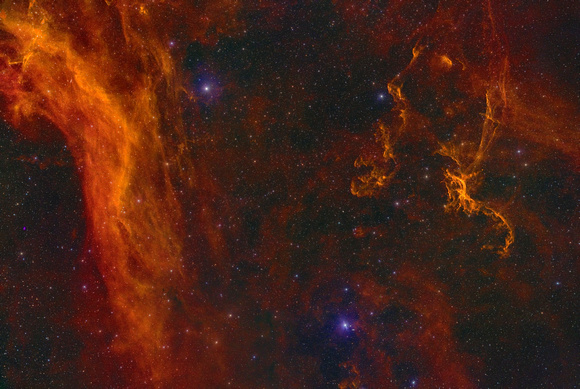Fire and Flying Dragons - SH2-113,114 in HSO
Fire and Flying Dragons – Sh2-113 and Sh2-114 in HSO (RGB Stars) (Cygnus) July,Aug 2023
Televue 127is; AP Mach2 GTO
ASI6200MM, - Baader RGB & 6.5nm NB CMOS opt. filters
H,S,O – (20,20x20 600s, Bin 1, Gain 100) & (18,14,14 x 300s, Bin 1, Gain 200)
R,G,B – (25,25,25 x 180x Bin 1, Gain 100) Total integration time = 17.5 hrs
The nebulosities on the right side and left side of this image represent a fundamental difference in the physical structure of the emitting gases. The left side is more representative of stellar winds and UV light impinging on a molecular cloud. Variation in emitted light intensity can be seen making the nebula look, well, like a cloud. In contrast the emitting gases on the right hand side is much more filamentatious or linear. This is much more reminiscent of a supernova remnant (SNR) , and creates the images of dragons in flight, with bat-wings and all. I also find the eerie image of a fact behind the lead bat on the RHS.
We “know” the RHS isn’t an SNR because the internet says there is no additional evidence to support this. (I think they mean – no black-hole/neutron star/white dwarf binary). So it is deemed a planetary nebula (PN), and while I don’t know what it is, I am fairly certain it isn’t a PN. Presumably, this would need a white dwarf too.
Another weird thing about this nebula is that while it is dim, it is comparably strong in the Ha and SII, yet has almost no OIII signal (again, supporting the fact that this is not a PN). Using a HSO palette seemed natural for this image, resulting in very firey looking image.
To add to the confusion, both Sh2-113 and Sh2-114 are deemed the “Flying Dragon Nebula”.
The Flying Dragons represented a bit of a challenge to image because it is quite dim, requiring a lot of integration time. When, in mid August, I went to process 3 nights of data taken in July, I had to get another night’s data to replace once lost to clouds and haze.
Behind the flying dragon is a creepy looking face, I am wondering if one of the Sharpless numbers refers to this. Curiously, all of the nebulosity seems to point to the bottom left, outside of the image, as the source of energizing UV light.


